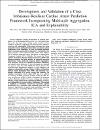Development and Validation of a Class Imbalance-Resilient Cardiac Arrest Prediction Framework Incorporating Multiscale Aggregation, ICA and Explainability

View/Open
Date
2024Author
Iffa Afsa, C.M.Ansari, Mohammed Yusuf
Paul, Santu
Halabi, Osama
Alataresh, Ezzedin
Shah, Jassim
Hamze, Afaf
Aboumarzouk, Omar
Al-Ansari, Abdulla
Dakua, Sarada Prasad
...show more authors ...show less authors
Metadata
Show full item recordAbstract
Objective: Despite advancements in artificial intelligence (AI) for predicting cardiac arrest (CA) with multivariate time-series vital signs data, existing models continue to face significant problems, particularly concerning balance, efficiency, accuracy, and explainability. While neural networks have been proposed to extract multiscale features from raw data in various applications, to our knowledge, no work has utilized multiscale feature extraction, specifically for diagnostic CA prediction. This paper presents a new framework that tackles these difficulties by utilizing multiscale feature aggregation via Independent Component Analysis (ICA). Methods: We present the Pareto optimal StrataChron Pyramid Fusion Framework (SPFF) that improves temporal vital signs statistics by capturing long-term dependencies using multi-scale temporal feature aggregation. SPFF integrates with ICA to eliminate information redundancy and enhance model efficiency. We have developed and validated the approach using the public MIMIC IV dataset. Results: The proposed model demonstrates resilience to data imbalance and enhances explainability through SHapley Additive exPlanations (SHAP), Partial Dependence Plots (PDP), and Individual Conditional Expectation (ICE) across varying time windows. The multilayer perceptron (MLP) using SPFF and ICA achieves an accuracy of 0.982, precision of 0.969, recall of 0.989, F1-score of 0.979, and AUROC of 0.998. Conclusion: The proposed method effectively predicts CA across varying time windows, offering a robust solution to the challenges of efficiency, accuracy, and explainability in current models. Significance: This method is significant to biomedical research as it provides superior performance in CA prediction while capturing both short- and long-term dependencies in patient data, potentially improving patient outcomes and guiding clinical decision-making.
Collections
- Computer Science & Engineering [2428 items ]
- Medicine Research [1739 items ]

